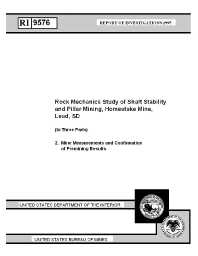Mining Publication: Rock Mechanics Study of Shaft Stability and Pillar Mining, Homestake Mine, Lead, SD (In Three Parts): 2. Mine Measurements and Confirmation of Premining Results
Original creation date: May 1995
A U.S. Bureau of Mines case study of pillar recovery in high-grade ore near the Ross shaft at the Homestake Mine, Lead, South Dakota, has demonstrated the usefulness of the finite-element method for evaluating shaft pillar mining plans and shaft stability. This report focuses on mine measurements and calibration of the two- dimensional computer model and is the second in a series of three reports of investigations describing the Ross shaft study. In this study, borehole extensometers and other instruments were installed to provide data for model verification and to monitor the shaft. Results of the recalibrated two-dimensional model (Utah2) confirmed the premining stability evaluation. However, after mining began, concern was expressed because cracks and other signs of ground motion appeared at considerable distances from the area of active pillar mining. In part 3 of the study, an intense three-dimensional modeling effort using Utah3 was initiated. The results again showed that the observed effects were within expectations and that the shaft would remain safe. Three-dimensional analyses of alternative pillar mining scenarios indicated that more of the shaft pillar ore reserve could be recovered than previously thought.
Authors: WG Pariseau, JC Johnson, MM McDonald, ME Poad
Report of Investigations - May 1995
NIOSHTIC2 Number: 10012576
U.S. Department of the Interior, Bureau of Mines, Report of Investigations 9576, NTIS stock number: PB96-107081, 1995 May; :1-20
See Also
- Development and Application of Reservoir Models and Artificial Neural Networks for Optimizing Ventilation Air Requirements in Development Mining of Coal Seams
- Elastic and Shear Moduli of Coal Measure Rocks Derived from Basic Well Logs Using Fractal Statistics and Radial Basis Functions
- The Ground Response Curve, Pillar Loading and Pillar Failure in Coal Mines
- Modeling and Prediction of Ventilation Methane Emissions of U.S. Longwall Mines Using Supervised Artificial Neural Networks
- Modernization and Further Development of the NIOSH Mine Emergency Response Training System (MERITS), Phase 1
- MULSIM/NL Application and Practitioner's Manual
- MULSIM/NL Theoretical and Programmer's Manual
- Pillar Strength and Design Methodology for Stone Mines
- Rock Mechanics Study of Shaft Stability and Pillar Mining, Homestake Mine, Lead, SD (In Three Parts): 3. Geomechanical Monitoring and Modeling Using UTAH3
- Use of Strain-Gauged Rock Bolts to Measure Rock Mass Strain During Drift Development
- Content source: National Institute for Occupational Safety and Health, Mining Program


 ShareCompartir
ShareCompartir
